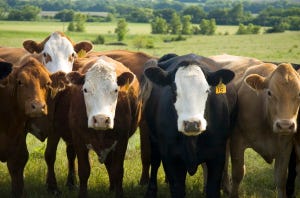What Do Genomic-Enhanced EPDs Contribute?
Say you have a group of 10 flush-mate Angus bulls. They all have the same EPDs because they’re all full brothers. Those EPD estimates are derived from the EPDs of the parents and, because no data on the calves has been collected, aren’t very accurate.

Watch a video interview with Sally Northcutt here.
Say you have a group of 10 flush-mate Angus bulls. They all have the same EPDs because they’re all full brothers. Those EPD estimates are derived from the EPDs of the parents and, because no data on the calves has been collected, aren’t very accurate.
Time goes on and weaning weights, yearling weights and ultrasound data are collected. As that information is added to the calculation, the EPDs for each animal not only become more accurate but change – some go up, some go down, some stay roughly the same.
But what happens when you throw DNA marker data into the mix? Adding genomic data should cause all the EPDs to go up, right? Nope.
Another piece to the puzzle
“Think of DNA like any other piece of information,” says Jennifer Bormann, Kansas State University geneticist. “It is additional information that gives us more insight into what that bull is – good or bad.” And just like adding any other piece of information to the EPD calculation, some EPDs will go up, some EPDs will go down, and some will stay the same.
Given that Angus, for the moment at least, is the only breed with genomic-enhanced EPDs, the effect of adding genomic data into the EPD calculation is seen only in the Angus breed. Several other breeds are on the cusp of developing their own genomic-enhanced EPDs; when they do, the addition of genomic data will have the same effect – some EPDs will go up, some will go down, some will stay the same.
That’s not necessarily a bad thing, Bormann says, because not every EPD is going to go up or down the same on every bull when the genomic data is figured into the calculation.
“Let’s say it’s not as good a carcass bull as you thought it would be, but maybe the growth or maternal EPDs go up. It helps you sort,” she says. And if, by adding the genomic data, a bull falls out of herd-bull consideration, the industry and that seedstock breeder’s customers are better off in the long run.
No drastic changes
Often, adding a genomic component into the EPD calculation doesn’t drastically change things, says Sally Northcutt, American Angus Association genetic research director. “A large proportion of the EPDs in the entire evaluation stay the same to provide stability from one evaluation release to the next,” she says.
But adding genomically charged data to the stew pot of numbers that breeders stir around to see if any good chunks rise to the top does give both the seedstock breeder and the commercial bull buyer important information. “I view the genomic results as an additional piece of information to better characterize the genetic merit on individuals,” Northcutt says.
For example, with the genetic piece of the puzzle spliced into the calculation, a very young bull can enter the Angus carcass evaluation.
“A calf at birth with a genomic result can enter the carcass evaluation and receive carcass EPDs. That’s despite the fact it’s never been scanned, we don’t know any assessment of its weight, and we don’t know what its future progeny are going to be like. But we can better characterize its genetic merit for the carcass traits – weight and marbling and rib and fat – based on that genomic result. And, fit it in with what we know about its relatives and its pedigree to compute EPDs for it,” Northcutt says.
Plus, adding the genomic data increases the accuracy of the EPDs of young calves, particularly on calves with pedigree-estimated EPDs formed using the sire and dam’s EPDs.
“Now with the genomic prediction, you can arrive at an accuracy level of a non-parent animal (an animal with no progeny records that can be used to refine the EPD estimate) similar to as if they had been weighed or measured,” Northcutt adds.
Rely on the EPD
For commercial bull buyers, that means nothing has changed, at least as far as how you select bulls. The EPD is the gold standard, just as it’s always been. But with Angus, EPDs are enhanced with the addition of genomic data. “Commercial bull buyers have a more accurate selection tool and they use the EPDs just like they always have,” Northcutt says.
As time progresses, other breeds will come online with genomic-enhanced EPDs, says Wade Shafer, American Simmental Association (ASA) director of performance programs. “The logical way to use genomic information effectively is to have it incorporated into the EPD,” he says. “Right now, Angus is the only breed that does.”
That will change. Simmental, Red Angus and Hereford are working on genomic panels specific to their breeds and will soon be able to offer genomic-enhanced EPDs. That’s important, Shafer says, because current genomic panels are only effective on the specific population for which they were developed.
Australian Angus vs. American Angus
As an example, Shafer cites the experience of Australian Angus breeders who tried to use genomic panels developed using American Angus genetics.
“Australian and American Angus cattle aren’t that different,” he says. “But there is enough difference in the populations that the American-developed panel was not very effective on Australian Angus. So they had to develop their own panel.”
That may change someday, he says, as the number of SNPs used in the panels are ratcheted up. Currently, the highest density test commercially available scans around 50,000 SNPs of the bovine genome.
“That used to be thought of as a high-density panel,” Shafer says. But panels that identify around 700,000 SNPs are now commonly being utilized in research efforts – including ASA research. “Conventional thought holds that as we increase the panel’s density, it will be more predictive across populations – but the jury is still out on that,” he adds.
Even as the density of genomic tests increase, EPDs will remain the main selection tool for commercial producers, Bormann says. That’s particularly true in multiple-trait selection, where indices have proven to be useful.
“A lot of breeds have come out with some very good indices that help those producers sort bulls without having every single particular EPD. The important thing is to find the index that fits your particular marketing system, whether you’re retaining ownership, selling at weaning, or keeping replacement heifers,” Bormann says. “Whatever your situation, you need to pick the index designed for that situation. And that’s really the best way to go about multiple-trait selection.”
Then there’s the wide world that spins, sometimes rapidly, outside the core of herd genetics. “We’re going to improve our tests where we can account for a larger percentage of the genetic variation. But if the heritability of a trait is 30%, say for weaning weight or yearling weight, there’s still all that environmental stuff out there that we need to manage for,” Bormann says.
The world of genetic improvement is advancing rapidly. And while that’s good for cow-calf producers, the information overload can be daunting.
“Using EPD and genomic results separately leads to double counting information and will lessen selection efficiency,” Northcutt says. “If you’re making selection decisions for traits that have an EPD provided, then the EPDs should be considered the selection tool of choice.”
Sidebar: Online accuracy calculator
The advantage of incorporating genomic data into EPDs is that it can increase the estimate’s accuracy. Just how much depends on the correlation between the trait of interest and the DNA test result. This correlation (dubbed “reliability” by genomics companies) is a necessary component in the calculation of DNA-enhanced EPDs. Hence, the American Angus Association (AAA) has calculated correlations for each of the DNA-enhanced traits and has them available on its website.
To help breeders better estimate the increase in EPD accuracy that genomic data can make possible, the American Simmental Association (ASA) has an online accuracy calculator.
“The accuracy calculator provides an objective framework from which breeders can make decisions about the utility of a genomic test,” says Wade Shafer, ASA director of performance programs. “If you play with it, you will quickly see that the value of a DNA test is highly contingent on the reliability of the test and the animal’s current accuracy level,” he says.
To give some perspective, the strongest correlation reported by AAA on DNA tests used in their evaluation is 0.65, Shafer says. “If you plug 0.65 in, along with the typical accuracy on a young animal with a phenotype reported (say 0.25), you will see a sizeable increase in accuracy. However, for a highly proven sire with an accuracy of 0.7, there will essentially be no increase in accuracy. In light of this fact, it makes sense to limit DNA testing to low to moderate accuracy animals.”
To access the calculator, go to www.simmental.org/calculator.
About the Author(s)
You May Also Like
.png?width=300&auto=webp&quality=80&disable=upscale)


